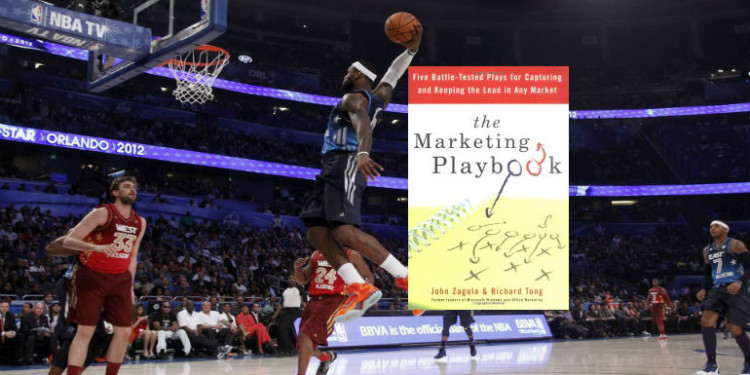The Five Essential Marketing Plays

Assess your market, your competition, and your strengths, then pick one of five essential marketing plays.
In The Marketing Playbook: Five Battle-Tested Plays for Capturing and Keeping the Lead in Any Market authors John Zagula and Richard Tong, now both at Ignition Capital, show how all marketing strategies can be condensed into one of five basic plays. Based on their experience at Microsoft with such products as Word and SQL server, Zagula and Tong distill a wide range of market opportunities down to a handful of strategic choices.
The Drag Race is a direct attack on a single competitor. The Platform Play invites others to support your growth and longevity. The Stealth Play is used when you’re at a disadvantage and need to find the blue ocean. The Best of Both Worlds combines previously separate segments of the market into a new offering. The High Low seeks to execute a one-two punch against a middle-of-the-road competitor.
The Drag Race
It makes sense to run a drag race when you can win
In the Drag Race play, single out a single competitor and attack them directly along a single set of product attributes. The first one to the finish line wins. Choose a single product and a single competitor and commit your resources, but make sure the market is right for this play.
A Drag Race is a good strategy if there is a large incumbent an you want to grab market share from them or if the market has many equal-sized competitors and you want to narrow it down to yourself and another competitor. Mustang vs. Camaro is an example of the former, a fast follower strategy, while Word vs. WordPerfect is an example of the latter, a market-clearing strategy. With Word, the authors defined Windows word processors as the head-to-head comparison they would drive towards. This narrow market segment definition allowed them to shorten the time required to win in the market.
In a Drag Race, it’s important that the customers have an investment in the outcome. Look for external events or other internal pressures which will entice customers to pay attention to the battle you are waging. Because timing and market conditions are so important for Drag Race success, make sure it’s easy for customers to switch. When salesforce.com went up against Seibel/Oracle, they made it easy for customers to switch to their SaaS solution.
Although the focusing power of the Drag Race is one of its primary advantages, choosing the right competitor is key. Netscape underestimated Microsoft during the early browser wars and lost a huge amount of market share. As the authors warn, make sure you can win.
The Platform Play
Successful companies that have stayed successful have almost always found ways to intertwine their success more deeply with the success of their whole industry.
Once a company is at the top of the market, the question becomes how to stay there. Zagula and Tong observe that this is the time to think more broadly about success and value. Rather than attempting to defend your well earned kingdom by yourself, enlist others to help you.
The Platform Play is the opposite of the Drag Race. Rather than directly confronting a single competitor, you get all market players involved in your goals and stay away from directly challenging anyone.
Examples of successful Platform plays are DoCoMo and amazon.
The Stealth Play
Astute and ongoing gap analysis is probably more important to the success of this play than to any other because the market gaps are smaller and your competency gaps are bigger.
The Stealth Play is more defensive in nature than the previous plays. Use this play when a strong competitor passes you buy (e.g. they just ran the Drag Race). Retreating or retrenching in the face of a dominant market leader can buy you time to position for longer term success.
The Enterprise rental car company found some space away from direct competitors by adopting a new business model that allowed them to build a revenue stream from insurance companies. Rather than competing head on with larger rental companies, they carved out a new market segment and grew to a more powerful position from there.
Survival is a lot more about being resourceful than about having lots of resources.
When larger players run a Drag Race against you or develop a dominant platform, the Stealth Play can give you the breathing room to recover to a position of strength. The Stealth Play consists of adding niche market segments until you are large enough to challenge the market leader. In addition to niches, add-ons to existing offerings and weaknesses in other products and services are opportunities to exploit with the Stealth Play.
Norton Utilities exploited a gap in the Microsoft Windows product as did Visio.
The Best of Both Worlds
Lexus is a classic Best of Both Worlds winner–high performance and styling paired with reliability and value. Lexus executed the Best of Both Worlds play at a time when Japanese cars were not known for quality or high end features.
The Best of Both Worlds aims at the broadest and yet most reliably profitable customer set possible. It sets its sights on the jackpot–regular, value-conscious consumers.
The time to select the Best of Both Worlds play is when two ends of the spectrum in your industry have existed for long enough to be considered as mutually exclusive. SUVs brought together heavy duty, off-road trucks with station wagons and sedan comfort. Early Compaq personal computers combined power and portability that previously were thought to be incompatible in the same package. Instead of aiming a single niche, this play aims to combine two separate niches that have never been combined. Irish Spring soap is “strong enough for a man, but made for a woman.”
The High Low Play
The High Low play is the inverse of the Best of Both Worlds. Rather than trying to squeeze up the middle, the High Low play is a pincer move to attack a competitor from both the high and low end of the market. This is the most complex of the five plays because it requires developing and coordinating two separate market offerings with distinct value propositions.
Microsoft executed this strategy with Windows and Windows NT. It trapped IBM’s OS/2 between a low-end and high-end offering that extinguished the competition.
Success with the High Low play means denying your competitor their Best of Both Worlds claim. You must close down your competitor’s ability to claim the middle ground. Moreover, a High Low strategy can be used to buy time until a Best of Both Worlds product is available. Customers must like the opposing poles of the market in order for the Best of Both Worlds play to work. If customers gravitate towards the center, then High Low won’t work. High Low requires a lot of attention because you need a balanced approach to both ends of the market rather than focusing on one or the other.







